Prediction of Structural Type for City-Scale Seismic Damage Simulation Based on Machine Learning
Abstract
1. Introduction
2. Framework
3. Supervised ML Solution
3.1. Determination of Models and Platforms
3.2. Data Processing
3.3. Model Training
- Component 1 (Select Data): Select the uploaded source data, i.e., Tangshan data.
- Component 2 (Select Model): Select “Multi-class Decision Forest” model in Azure for the prediction.
- Component 3 (Split Data): Split the source data into training data (i.e., 80% of the source data) and assessment data (i.e., the remaining 20% of the source data).
- Component 4 (Train Model): Train the prediction model using the training data.
- Component 5 (Score Model): Score the prediction results using the assessment data.
- Component 6 (Evaluate Model): Evaluate the accuracy of the prediction model.
3.4. Scale Sensitivity Assessment
3.5. Regional Applicability Assessment
4. Semi-Supervised ML Solution
4.1. Determination of Sampling Fraction
4.2. Semi-Supervised ML Solution
- Component 1 (Data Set): Select the sample data from the building investigation, i.e., 3% of buildings in Tangshan.
- Component 2 (Split Data): 1/3 of the sample data are used for training the model (i.e., Component 5), while the remaining 2/3 of the data are used for scoring the model (i.e., Component 6).
- Component 3 (Convert to CSV): Export the training data to CSV format for the subsequent training.
- Component 4 (Multi-class Decision Forest): Select the multi-class decision forest model for prediction.
- Component 5 (Train Model): Train the selected ML model using the training data.
- Component 6 (Score Model): Score the accuracies of the prediction results with the assessment data, as shown in Figure 13. By doing this, the building data with high accuracies will be identified. In this study, the building data ranked top 1% in the scored probabilities will be selected for the next training.
- Component 7 (Evaluate Model): Evaluate the performance of the prediction model and output the evaluation results. As shown in Figure 14, the overall prediction accuracy of the first self-training reaches 95.5%. However, the accuracy of the frame structure is only 81.7%, which is not acceptable; therefore, a second self-training is required.
- Component 8 (Convert to CSV): Convert the building data with high accuracies (see Component 6) to CSV format such that these data can be used for the second self-training.
5. Case Study
5.1. Introduction of Case Study
5.2. Structural Type Prediction for Daxing Downtown
5.3. Seismic Damage Simulation for Daxing Downtown
5.4. Structural Type Prediction for Tongzhou Downtown
5.5. Seismic Damage Simulation for Tongzhou Downtown
6. Conclusions
- (1)
- The prediction result of the designed supervised ML solution for Tangshan with 230,683 buildings indicated that decision forest, artificial neural network and logistic regression models exhibited high prediction accuracy. Especially, the decision forest model has the best performance and is recommended to predict structural types.
- (2)
- The designed supervised ML solution could maintain high prediction accuracy for different building scales; however, it should be applied for cities similar to the sample city.
- (3)
- The designed semi-supervised ML solution was applicable to different cities, based on a sampling investigation. According to the prediction with different sampling fractions, the sampling fraction of 1% is recommended. Through multiple self-trainings, the semi-supervised ML solution achieved high accuracy for predicting structural types.
- (4)
- This study provided a smart and efficient method to predict structural type for a city-scale seismic damage simulation.
Author Contributions
Funding
Conflicts of Interest
References
- Reyners, M. Lessons from the destructive mw 6.3 Christchurch, New Zealand, earthquake. Seismol. Res. Lett. 2011, 82, 371–372. [Google Scholar] [CrossRef]
- Li, Z.; Ni, S.; Roecker, S. Seismic imaging of source region in the 1976 M s 7.8 Tangshan earthquake sequence and its implications for the seismogenesis of intraplate earthquakes. Bull. Seismol. Soc. Am. 2018, 108, 1302–1313. [Google Scholar] [CrossRef]
- Ministry of Housing and Urban-Rural Development. Code for Seismic Design of Building (GB 50011-2010); China Architecture Industry Press: Beijing, China, 2016. [Google Scholar]
- Lu, X.; Han, B.; Hori, M.; Xiong, C.; Xu, Z. A coarse-grained parallel approach for seismic damage simulations of urban areas based on refined models and GPU/CPU cooperative computing. Adv. Eng. Softw. 2014, 70, 90–103. [Google Scholar] [CrossRef]
- Lu, X.; Guan, H. Earthquake Disaster Simulation of Civil Infrastructures: From Tall Buildings to Urban Areas; Springer and Science Press: Beijing, China, 2017. [Google Scholar]
- Xiong, C.; Lu, X.; Guan, H.; Xu, Z. A nonlinear computational model for regional seismic simulation of tall buildings. Bull. Earthq. Eng. 2016, 14, 1047–1069. [Google Scholar] [CrossRef]
- Xiong, C.; Lu, X.; Lin, X.; Ye, L. Parameter determination and damage assessment for THA-based regional seismic damage prediction of multi-story buildings. J. Earthq. Eng. 2017, 21, 461–485. [Google Scholar] [CrossRef]
- Xu, Z.; Lu, X.; Guan, H.; Han, B.; Ren, A. Seismic damage simulation in urban areas based on a high-fidelity structural model and a physics engine. Nat. Hazards 2014, 71, 1679–1693. [Google Scholar] [CrossRef]
- Xiong, C.; Lu, X.; Huang, J.; Guan, H. Multi-LOD seismic-damage simulation of urban buildings and case study in Beijing CBD. Bull. Earthq. Eng. 2019, 17, 2037–2057. [Google Scholar] [CrossRef]
- Lu, X.; Frank, M.; Cheng, Q.L.; Xu, Z.; Zeng, X.; Stephen, M. An open-source framework for regional earthquake loss estimation using the city-scale nonlinear time-history analysis. Earthq. Spectra 2020. [Google Scholar] [CrossRef]
- Li, S.; Tang, H.; Huang, X.; Mao, T.; Niu, X. Automated detection of buildings from heterogeneous VHR satellite images for rapid response to natural disasters. Remote Sens. 2017, 9, 1177. [Google Scholar] [CrossRef]
- Kadhim, N.; Mourshed, M. A shadow-overlapping algorithm for estimating building heights from VHR satellite images. IEEE Geosci. Remote Sens. Soc. 2017, 15, 8–12. [Google Scholar] [CrossRef]
- Ministry of Housing and Urban-Rural Development. Design Code for Residential Buildings (GB 50096-2011); China Architecture Industry Press: Beijing, China, 2011. [Google Scholar]
- Tian, J.; Cui, S.; Reinartz, P. Building change detection based on satellite stereo imagery and digital surface models. IEEE Geosci. Remote Sens. Soc. 2013, 52, 406–417. [Google Scholar] [CrossRef]
- DataSF. Available online: https://datasf.org/opendata/ (accessed on 22 February 2020).
- Bishop, C.M. Pattern Recognition and Machine Learning; Springer: New York, NY, USA, 2006. [Google Scholar]
- Krijnen, T.; Tamke, M. Assessing Implicit Knowledge in BIM Models with Machine Learning. In Modelling Behaviour; Springer: Den Dolech, The Netherlands, 2015; pp. 397–406. [Google Scholar]
- Dornaika, F.; Moujahid, A.; El Merabet, Y.; Ruichek, Y. Building detection from orthophotos using a machine learning approach: An empirical study on image segmentation and descriptors. Expert Syst. Appl. 2016, 58, 130–142. [Google Scholar] [CrossRef]
- Yuan, J.; Cheriyadat, A.M. Combining maps and street level images for building height and facade estimation. In Proceedings of the 2nd ACM SIGSPATIAL Workshop on Smart Cities and Urban Analytics, Burlingame, CA, USA, 31 October 2016; p. 8. [Google Scholar]
- Yuan, J. Learning building extraction in aerial scenes with convolutional networks. IEEE Trans. Pattern Anal. Mach. Intell. 2017, 40, 2793–2798. [Google Scholar] [CrossRef] [PubMed]
- Bassier, M.; Vergauwen, M.; Van Genechten, B. Automated classification of heritage buildings for as-built BIM using machine learning techniques. ISPRS Ann. Photogramm. Remote Sens. Spat. Inf. Sci. 2017, IV-2/W2, 25–30. [Google Scholar] [CrossRef]
- Dreiseitl, S.; Ohno-Machado, L. Logistic regression and artificial neural network classification models: A methodology review. J. Biomed. Inform. 2002, 35, 352–359. [Google Scholar] [CrossRef]
- Tao, J.; Klette, R. Integrated pedestrian and direction classification using a random decision forest. In Proceedings of the IEEE International Conference on Computer Vision Workshops, Sydney, Australia, 1–8 December 2013; pp. 230–237. [Google Scholar]
- Wang, L. Support Vector Machines: Theory and Applications; Springer: Dordrecht, The Netherlands, 2005. [Google Scholar]
- Kleinbaum, D.G.; Dietz, K.; Gail, M.; Klein, M.; Klein, M. Logistic Regression; Springer: New York, NY, USA, 2002. [Google Scholar]
- BigML. Available online: https://bigml.com/ (accessed on 17 December 2019).
- Microsoft Azure Machine Learning Platform. Available online: https://studio.azureml.net/ (accessed on 17 December 2019).
- TensorFlow. Available online: https://tensorflow.google.cn/ (accessed on 17 December 2019).
- Amazon Machine Learning. Available online: https://aws.amazon.com/cn/machine-learning/ (accessed on 17 December 2019).
- Zhu, X.; Goldberg, A.B. Introduction to semi-supervised learning. Synth. Lect. Artif. Intell. Mach. Learn. 2009, 3, 1–130. [Google Scholar] [CrossRef]
- Ali Humayun, M.; Hameed, I.A.; Muslim Shah, S.; Hassan Khan, S.; Zafar, I.; Bin Ahmed, S.; Shuja, J. Regularized Urdu speech recognition with semi-supervised deep learning. Appl. Sci. 2019, 9, 1956. [Google Scholar] [CrossRef]
- Khan, J.; Lee, Y.K. LeSSA: A unified framework based on lexicons and semi-supervised learning approaches for textual sentiment classification. Appl. Sci. 2019, 9, 5562. [Google Scholar] [CrossRef]
- Wang, X.; Feng, X.; Xu, X.; Diao, G.; Wan, Y.; Wang, L.; Ma, G. Fault plane parameters of Sanhe-Pinggu M8 earthquake in 1679 determined using present-day small earthquakes. Earthq. Sci. 2014, 27, 607–614. [Google Scholar] [CrossRef]
- Fu, C.; Gao, M.; Chen, K. A study on long-period response spectrum of ground motion affected by basin structure of Beijing. Acta Seismol. Sin. 2012, 34, 374–382. [Google Scholar]
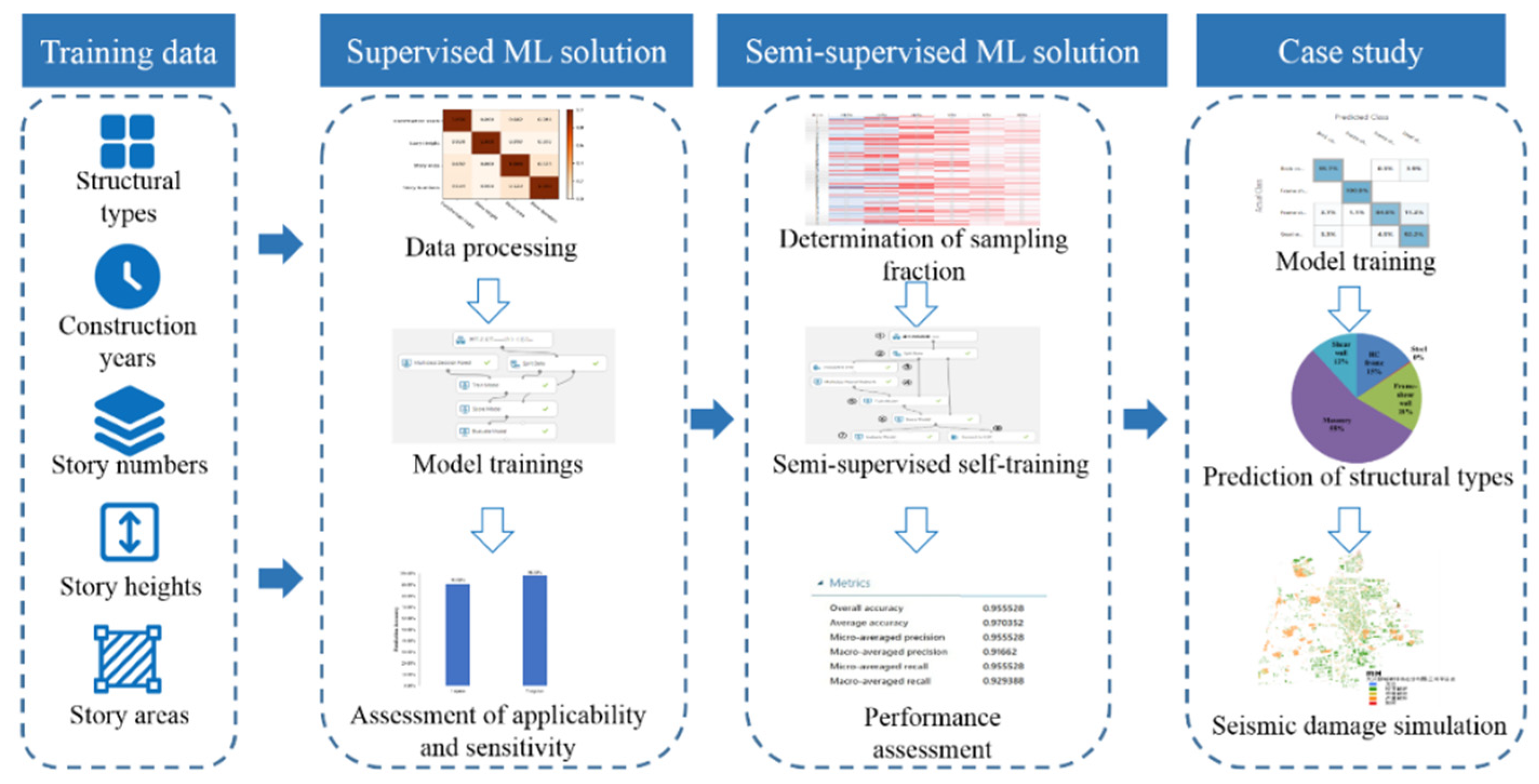

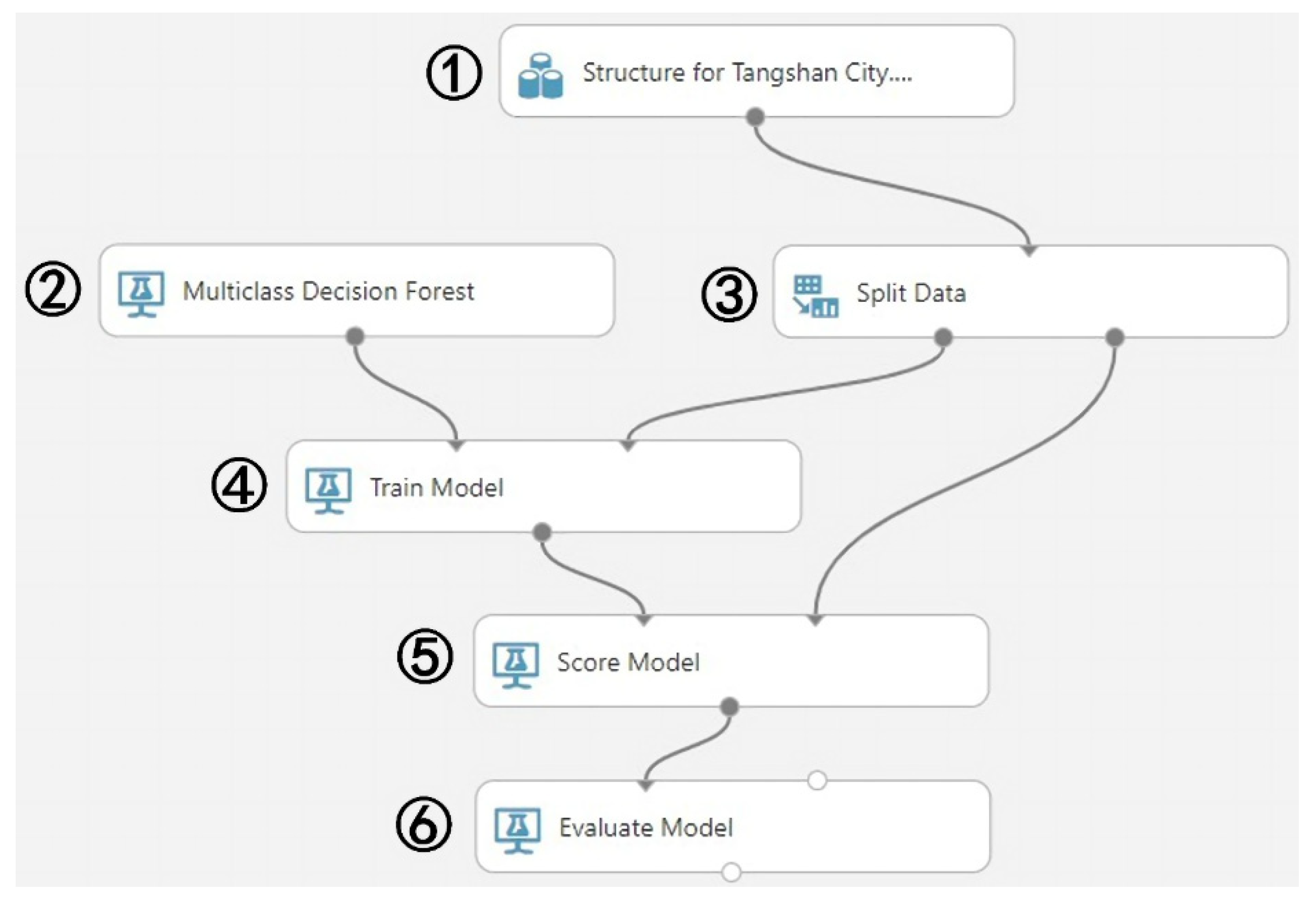
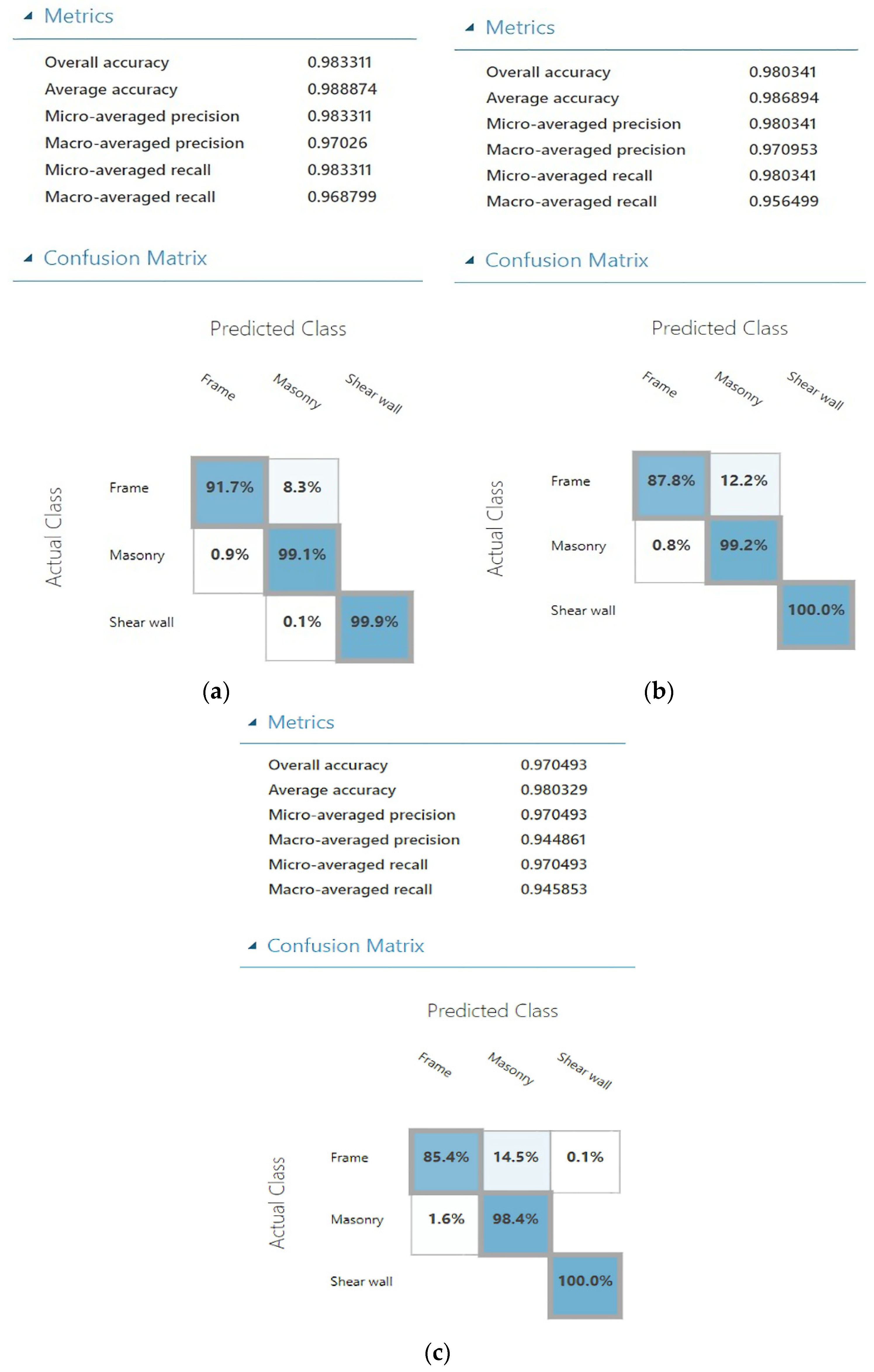
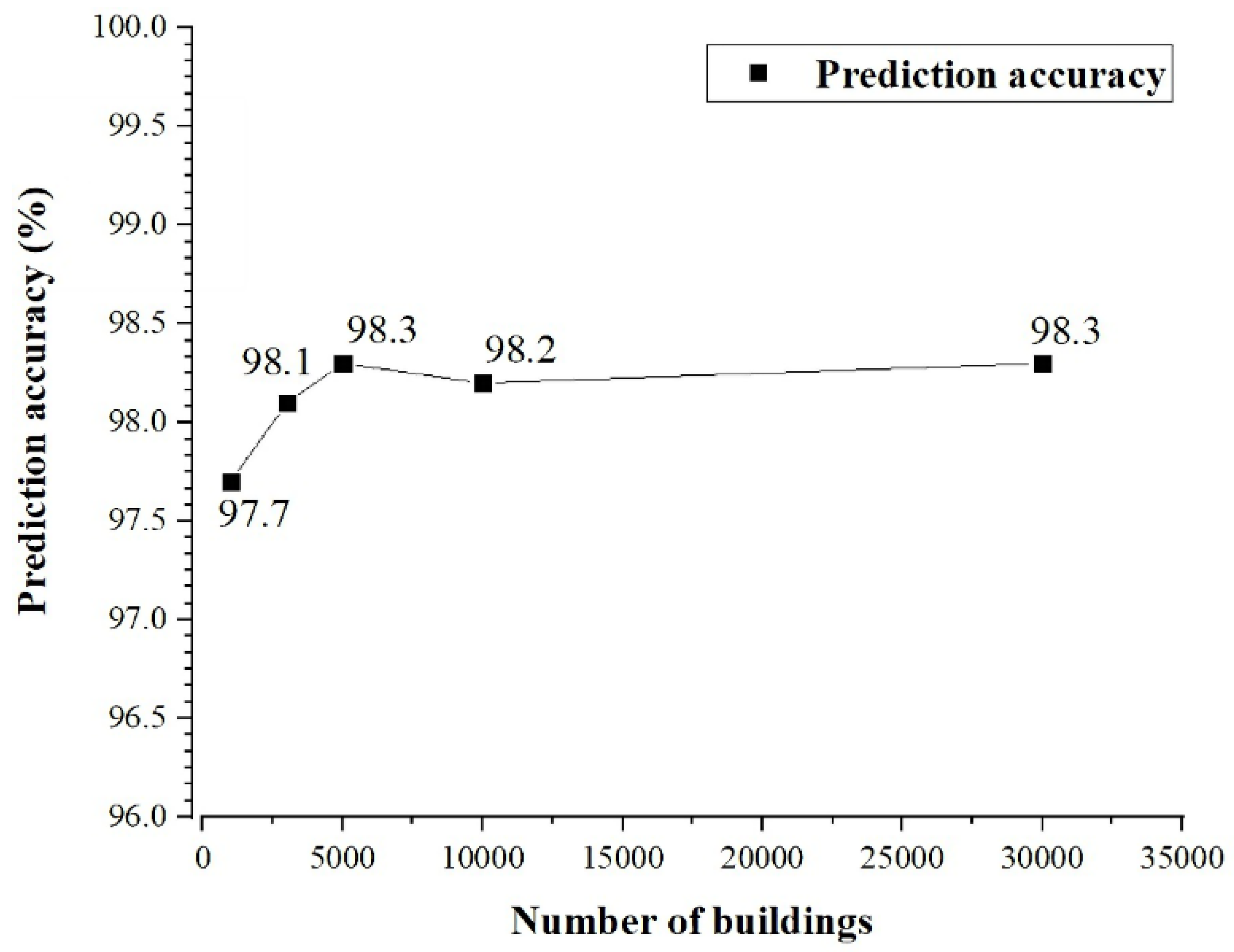
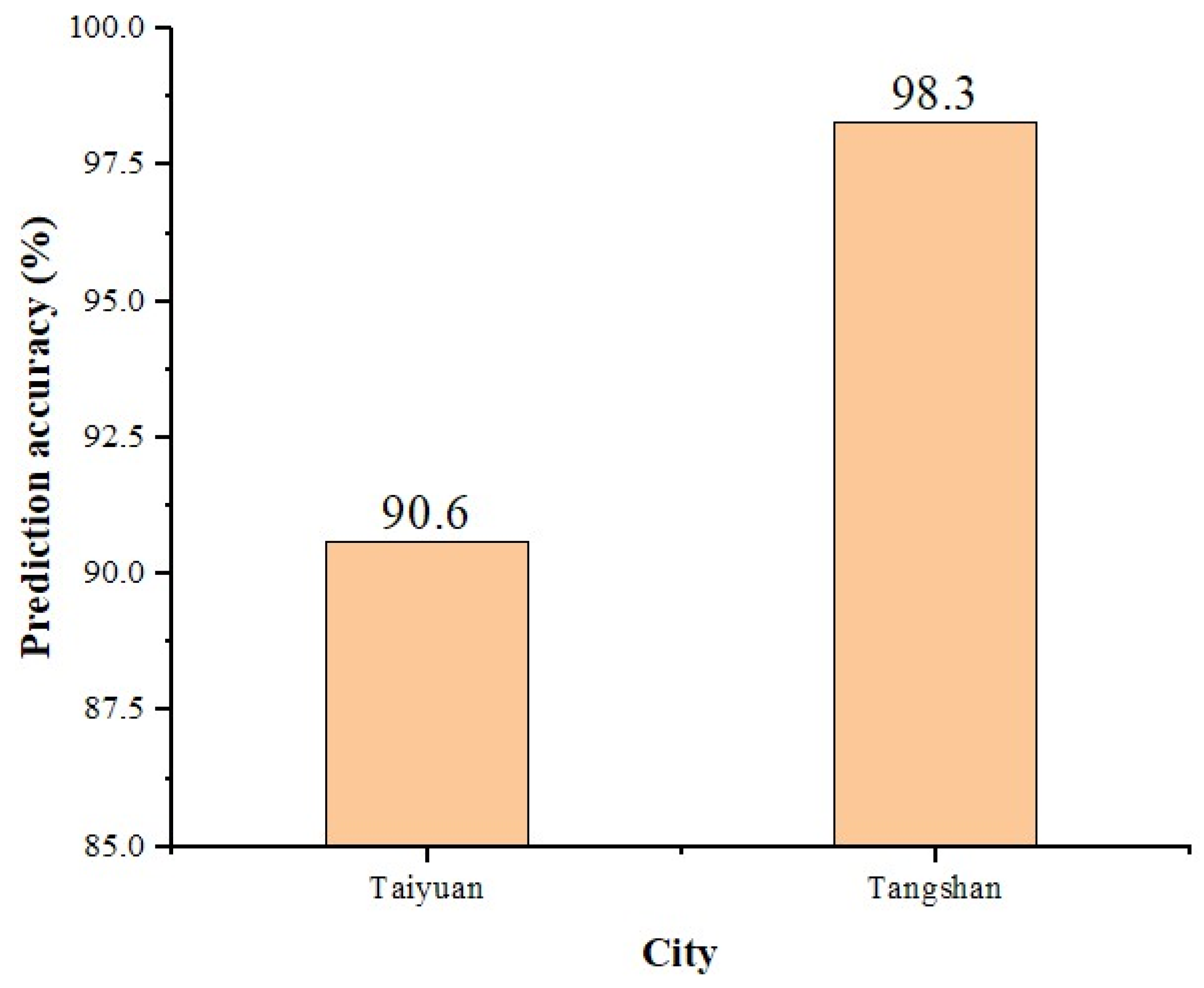
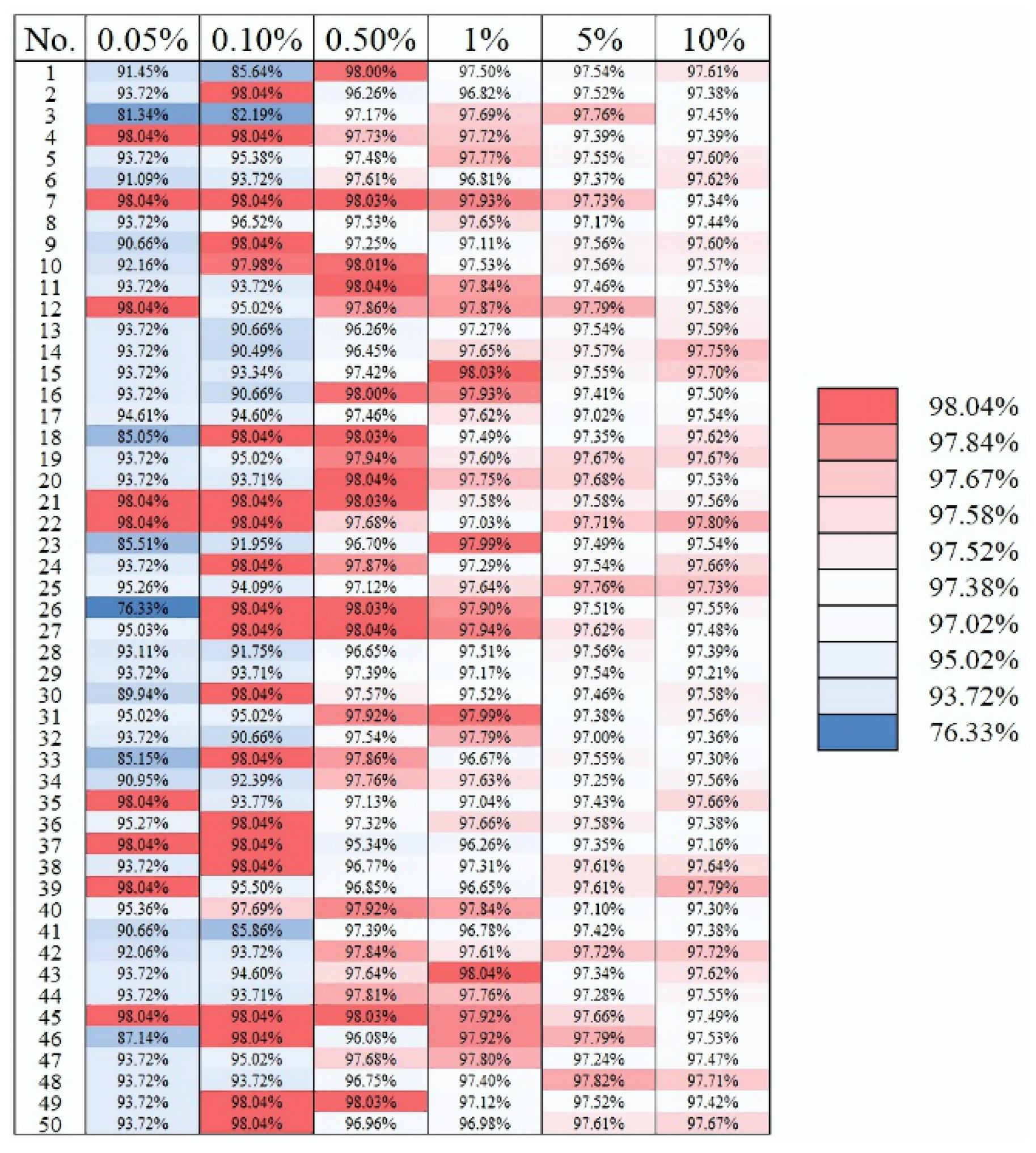
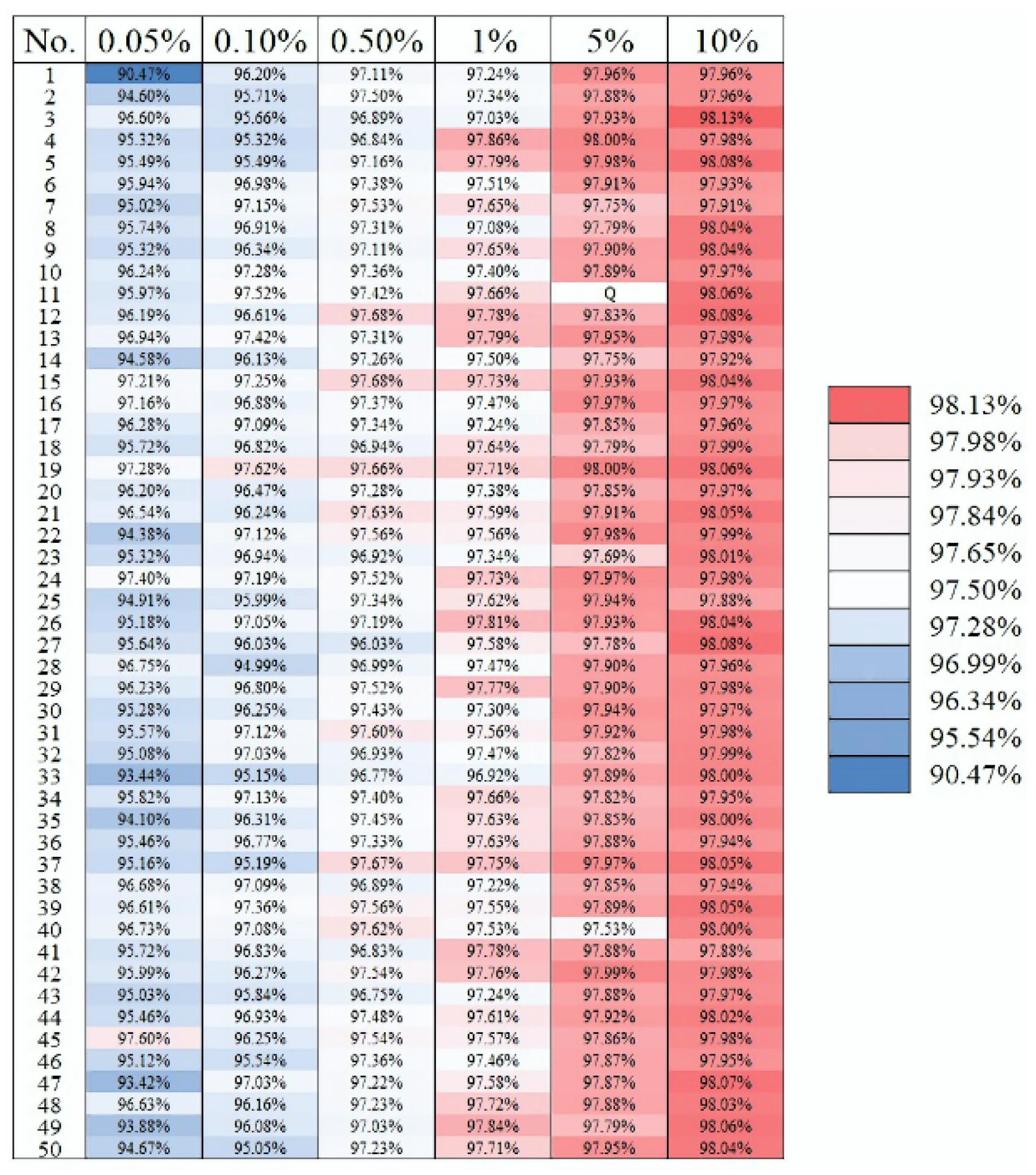
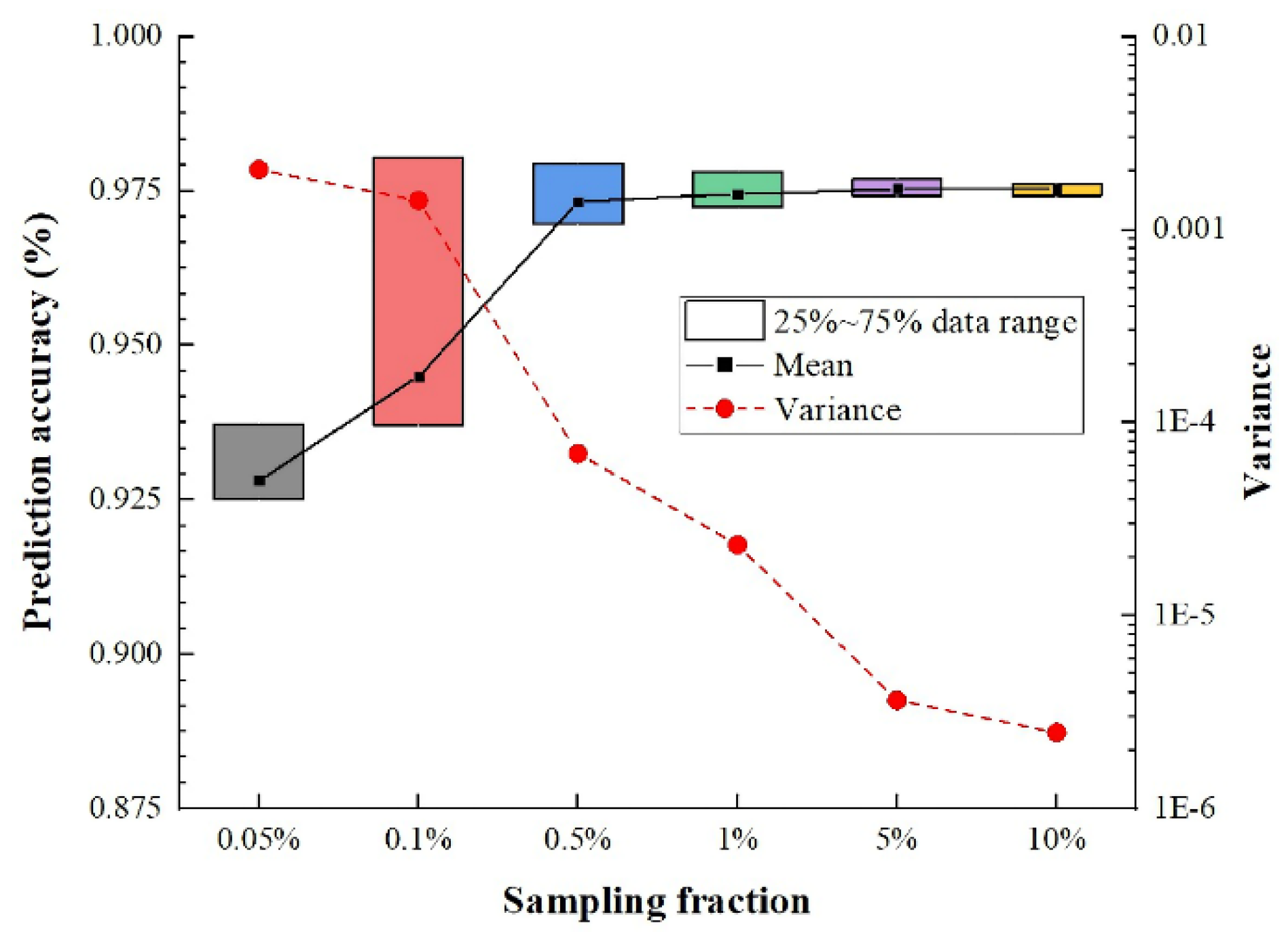
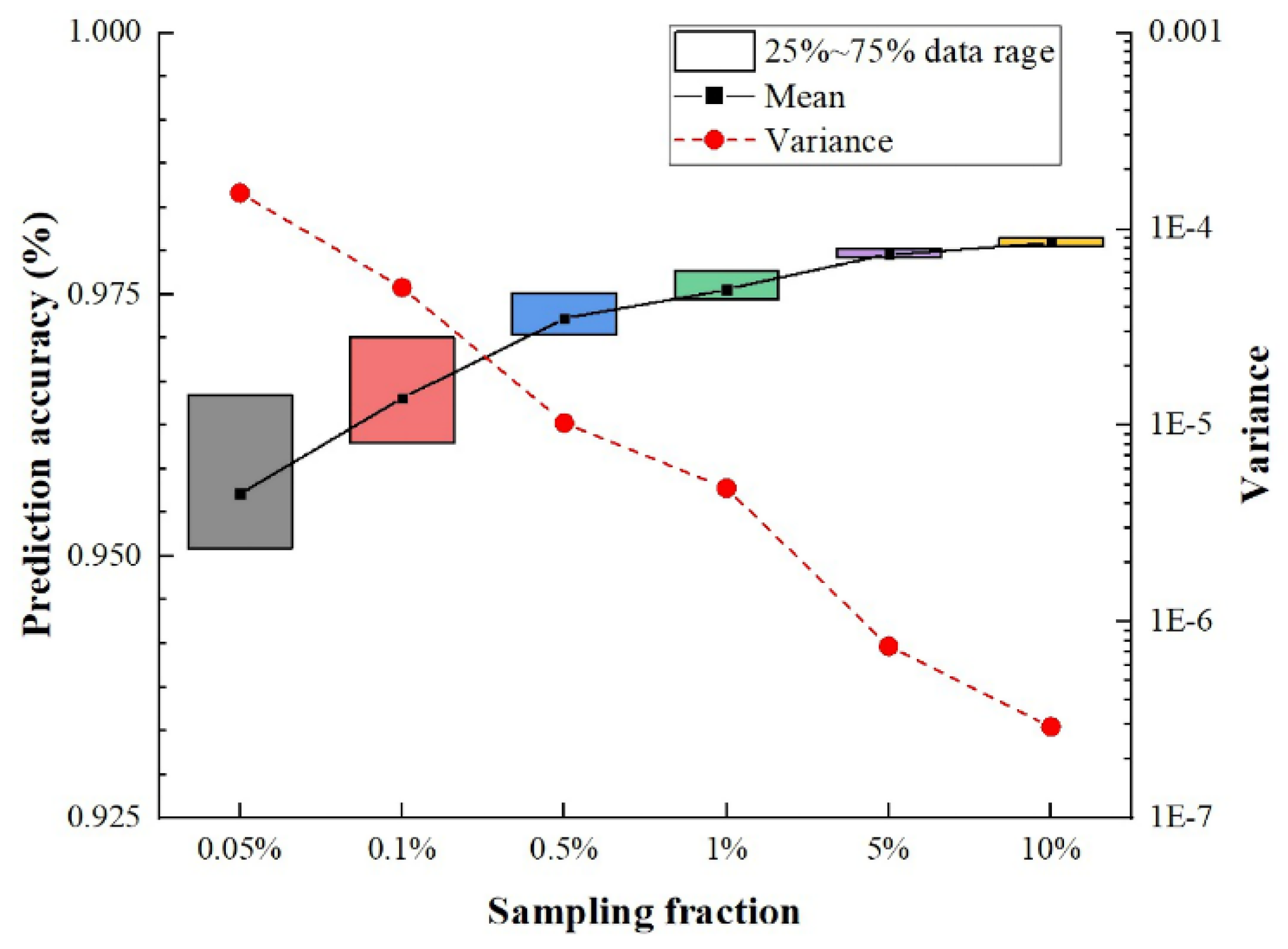
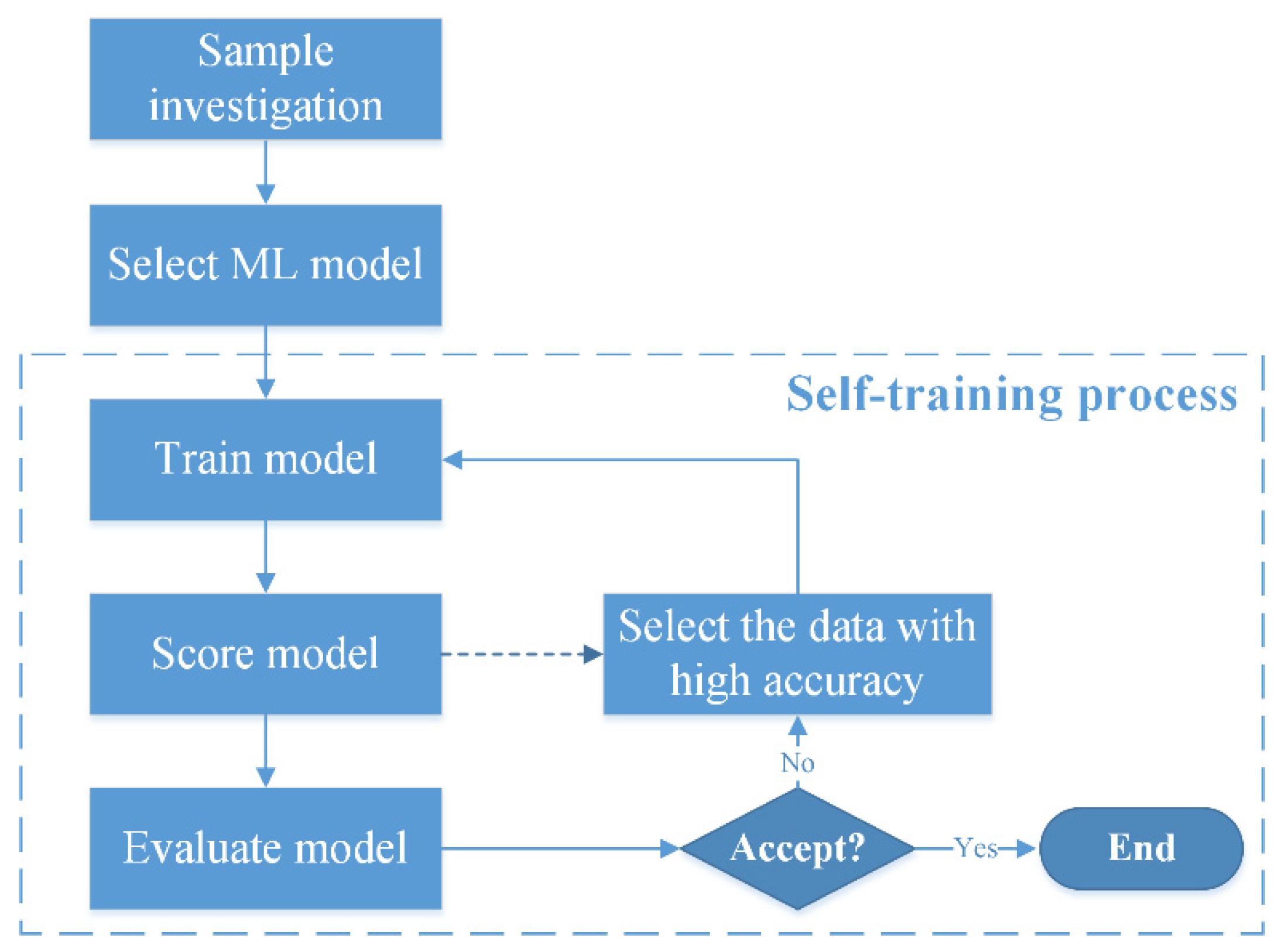
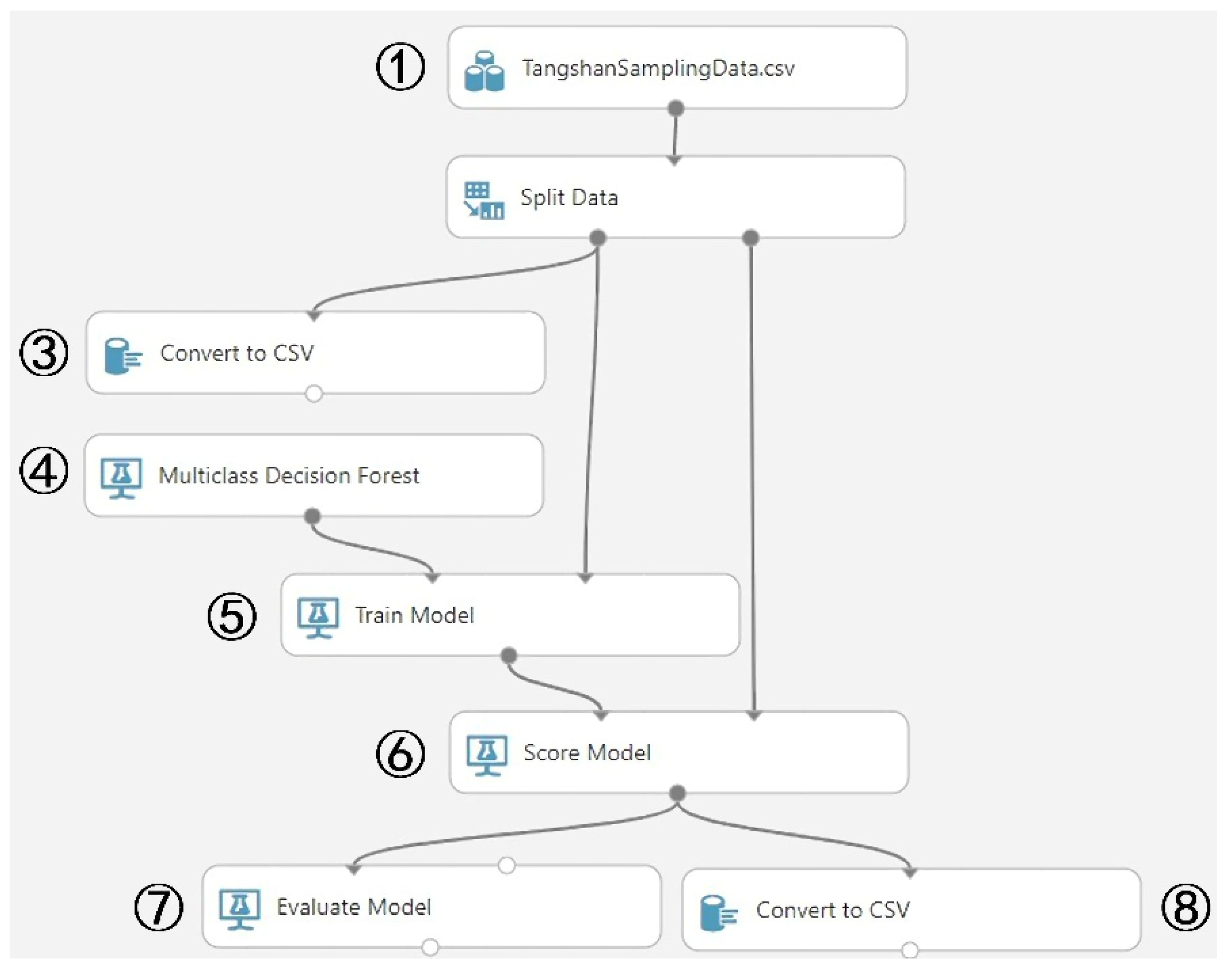

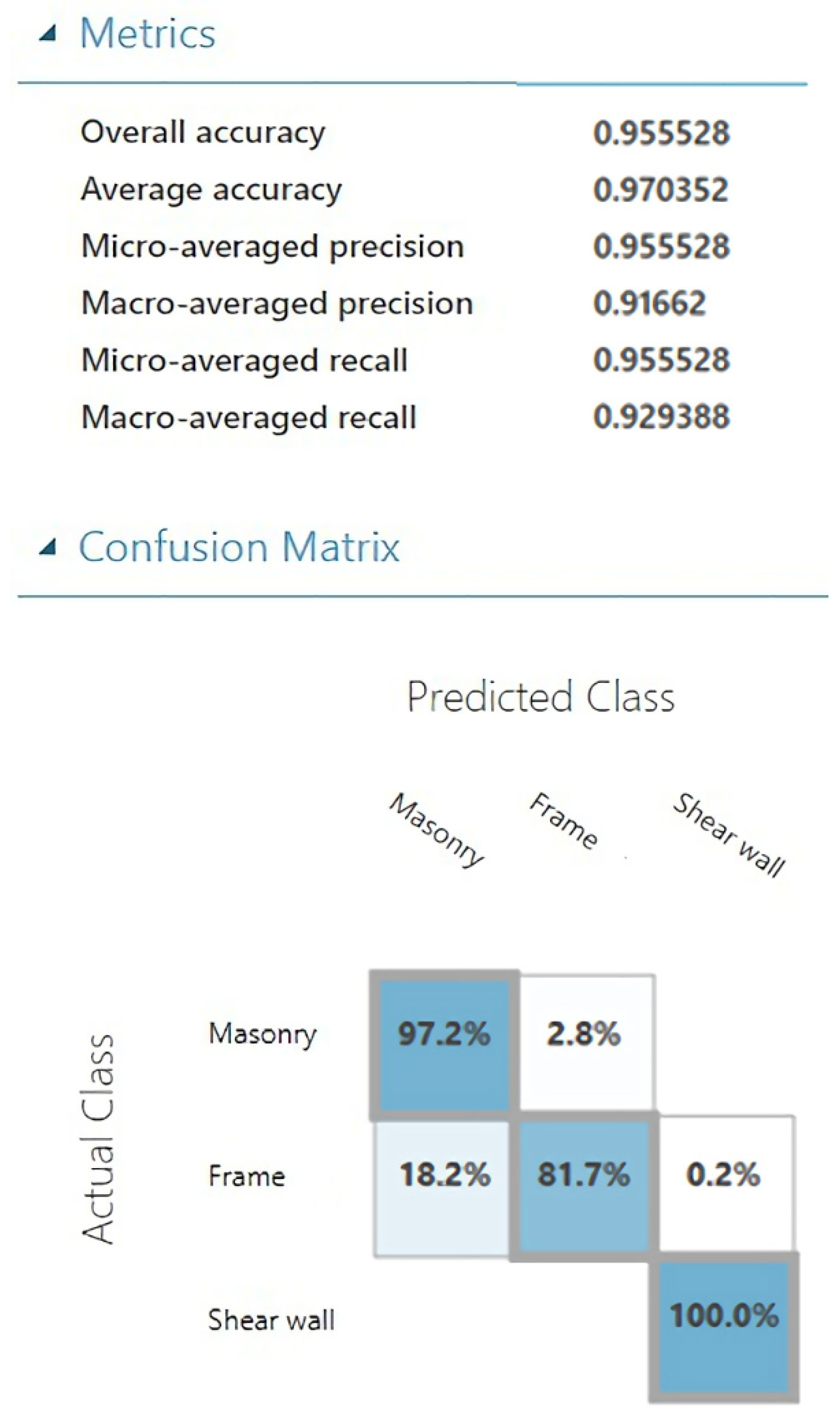
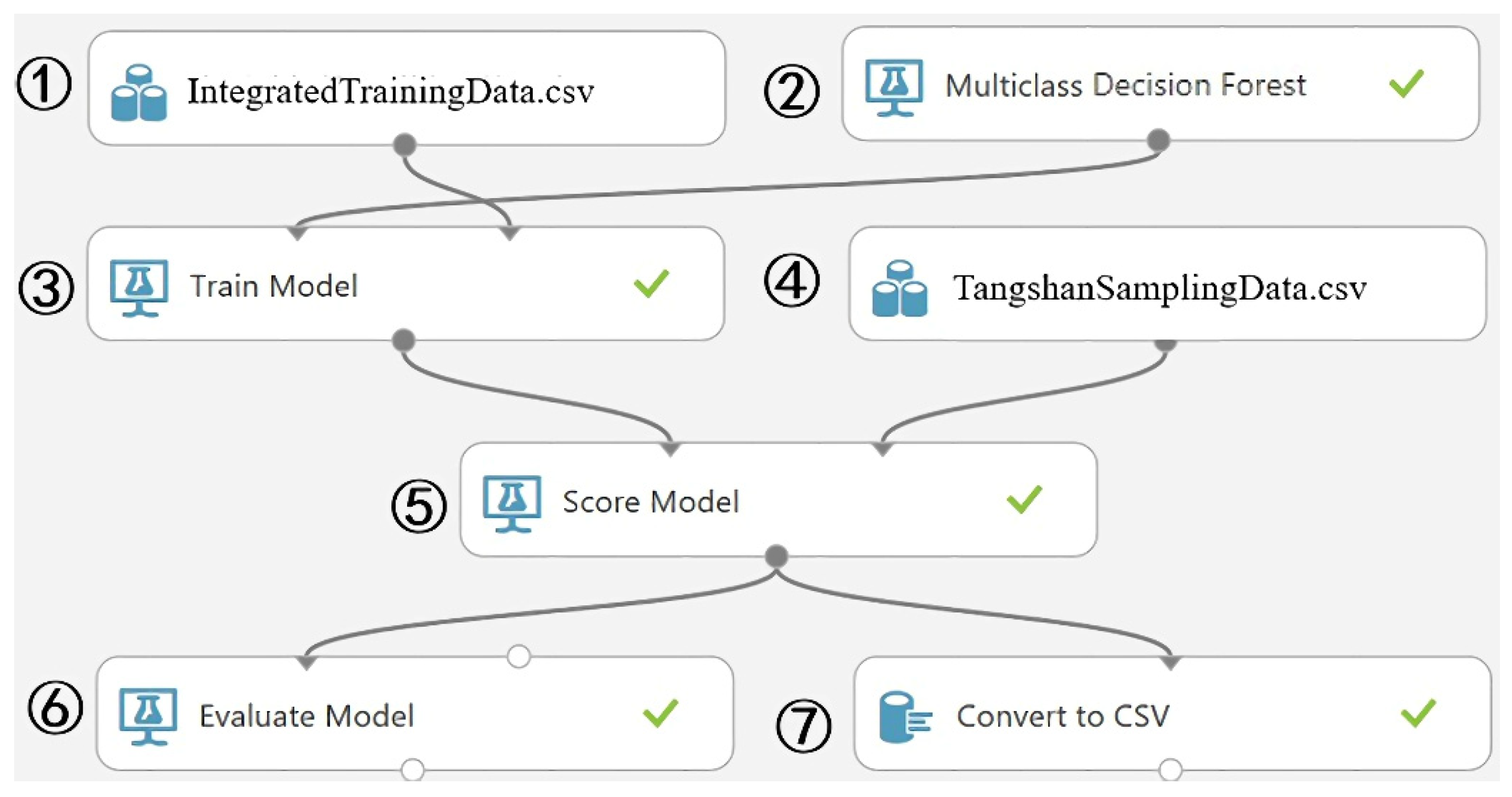
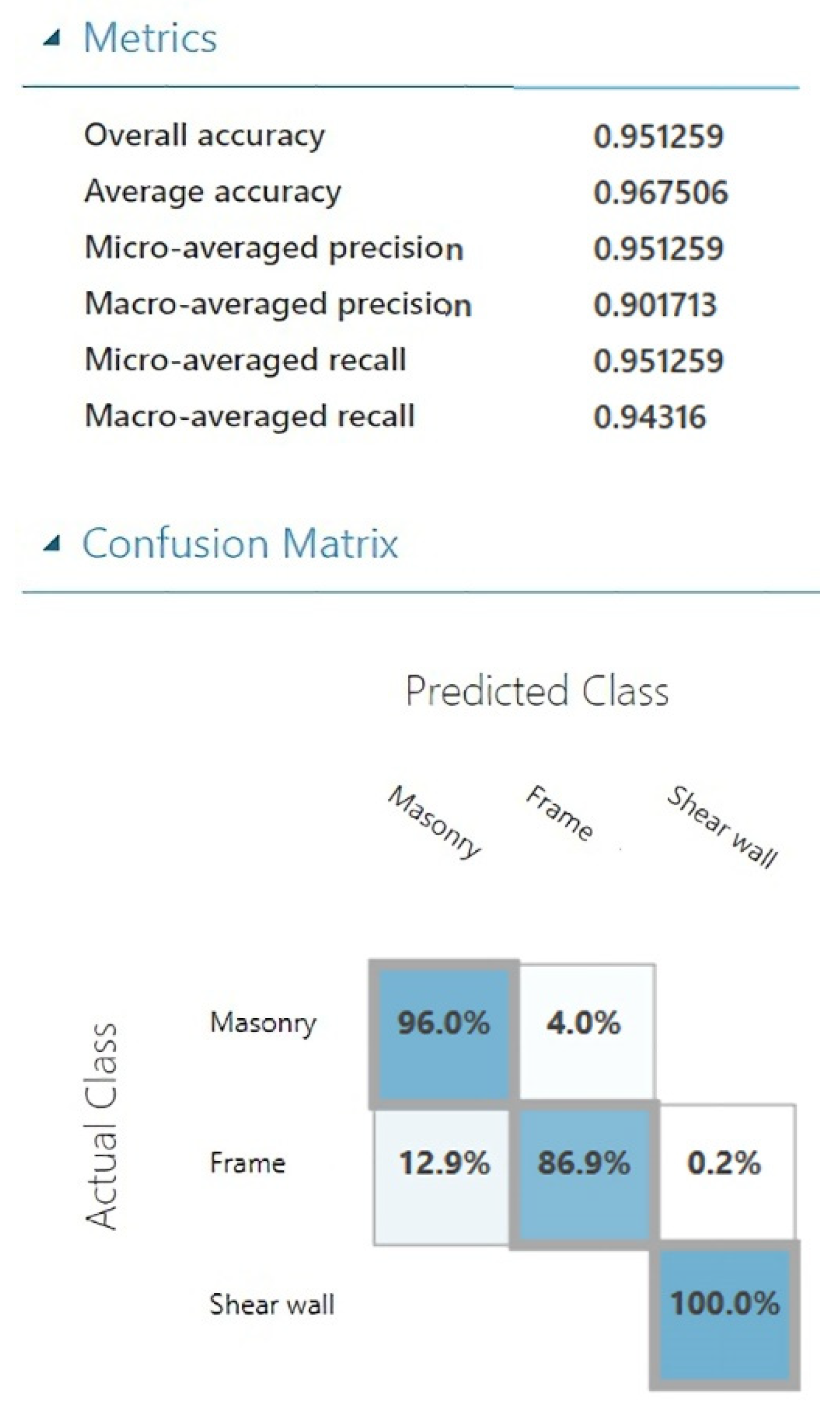
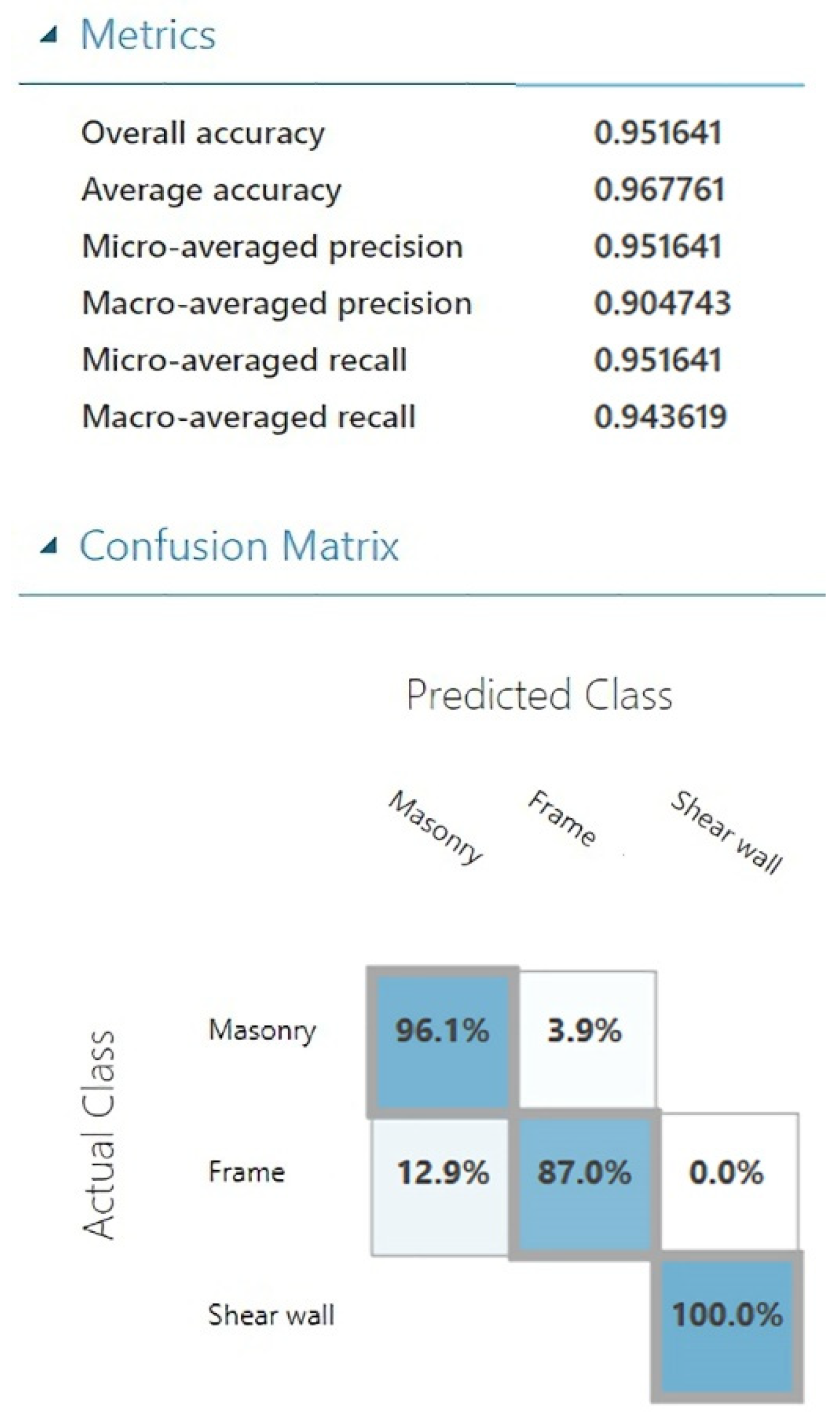
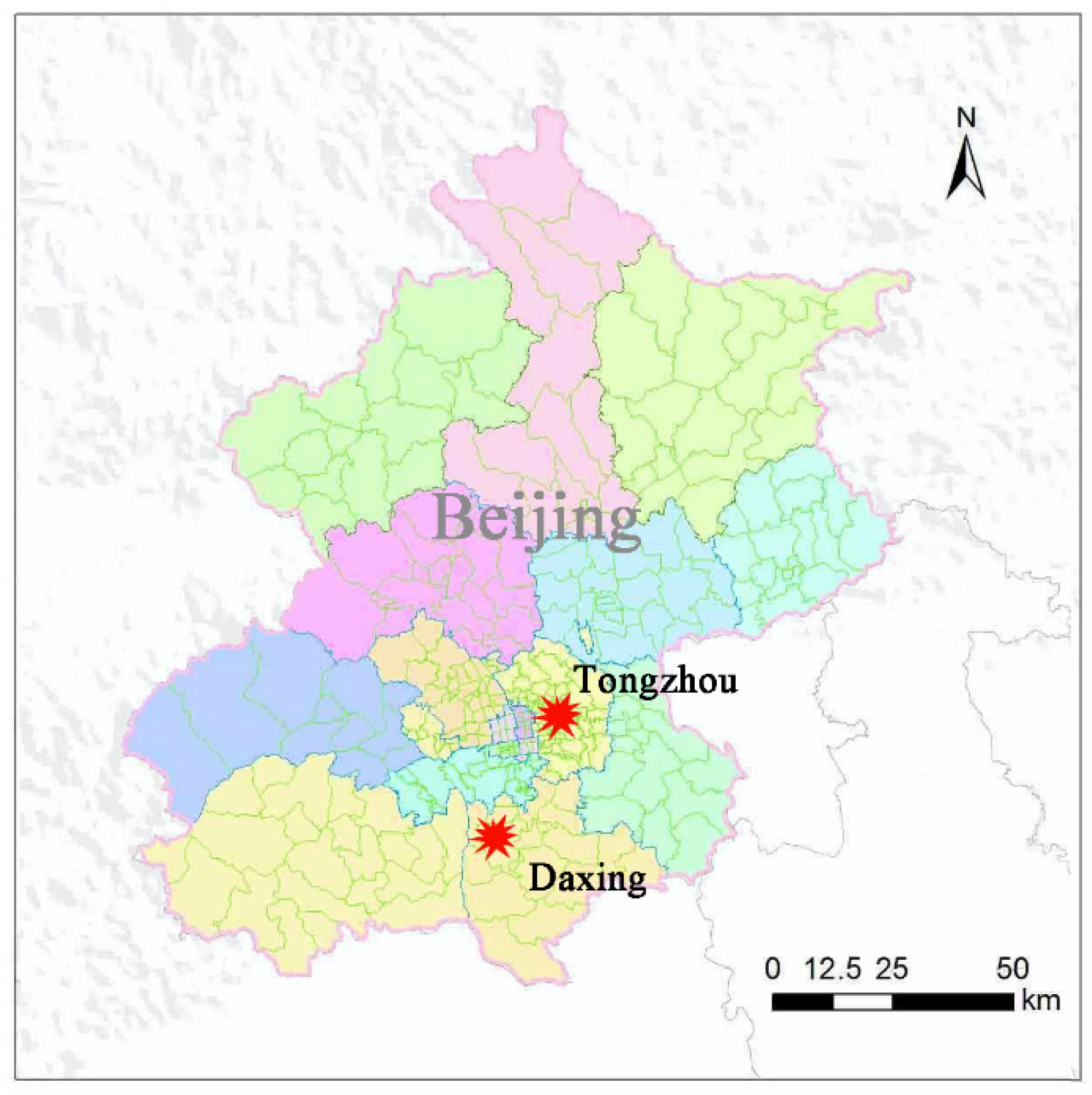
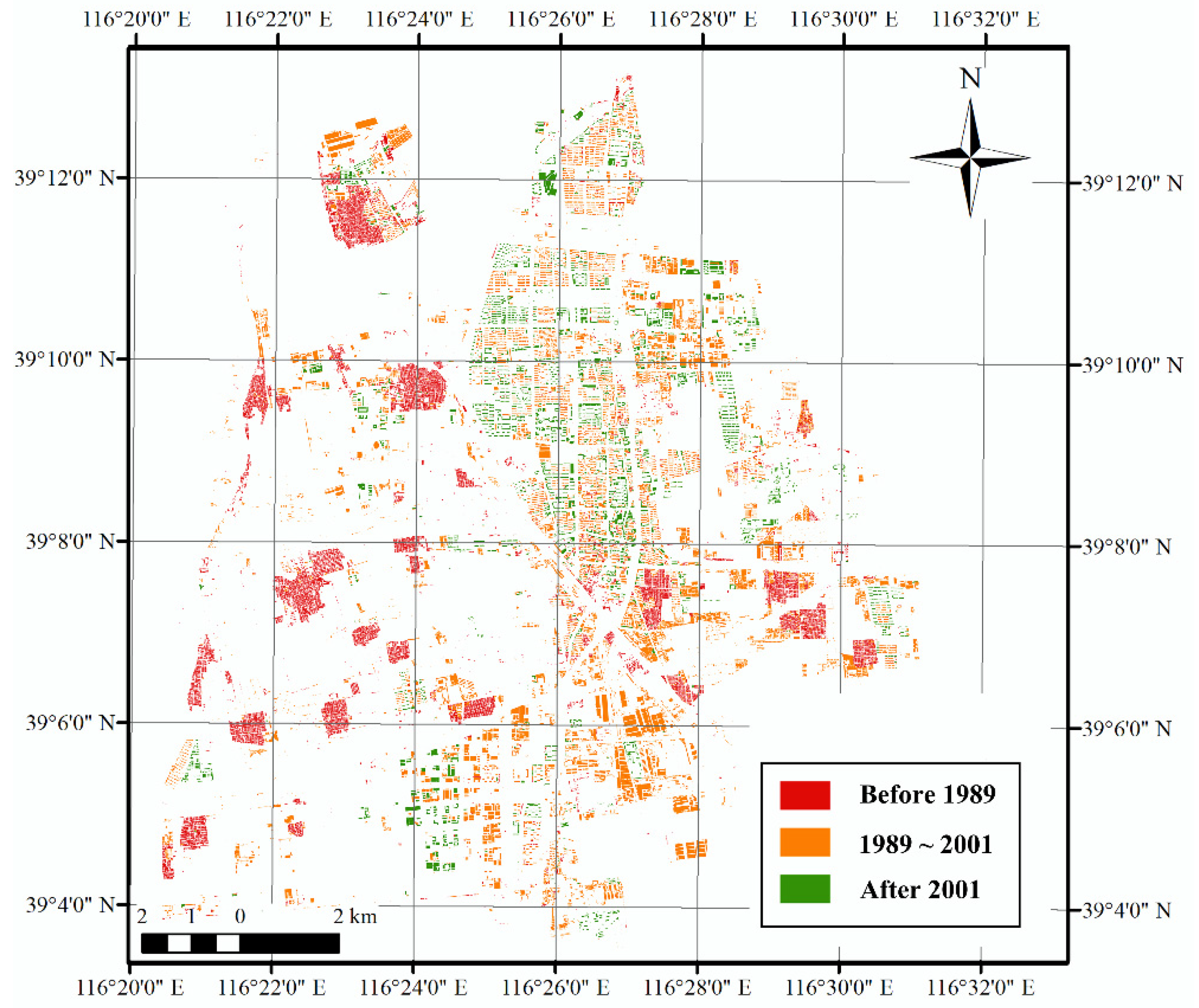
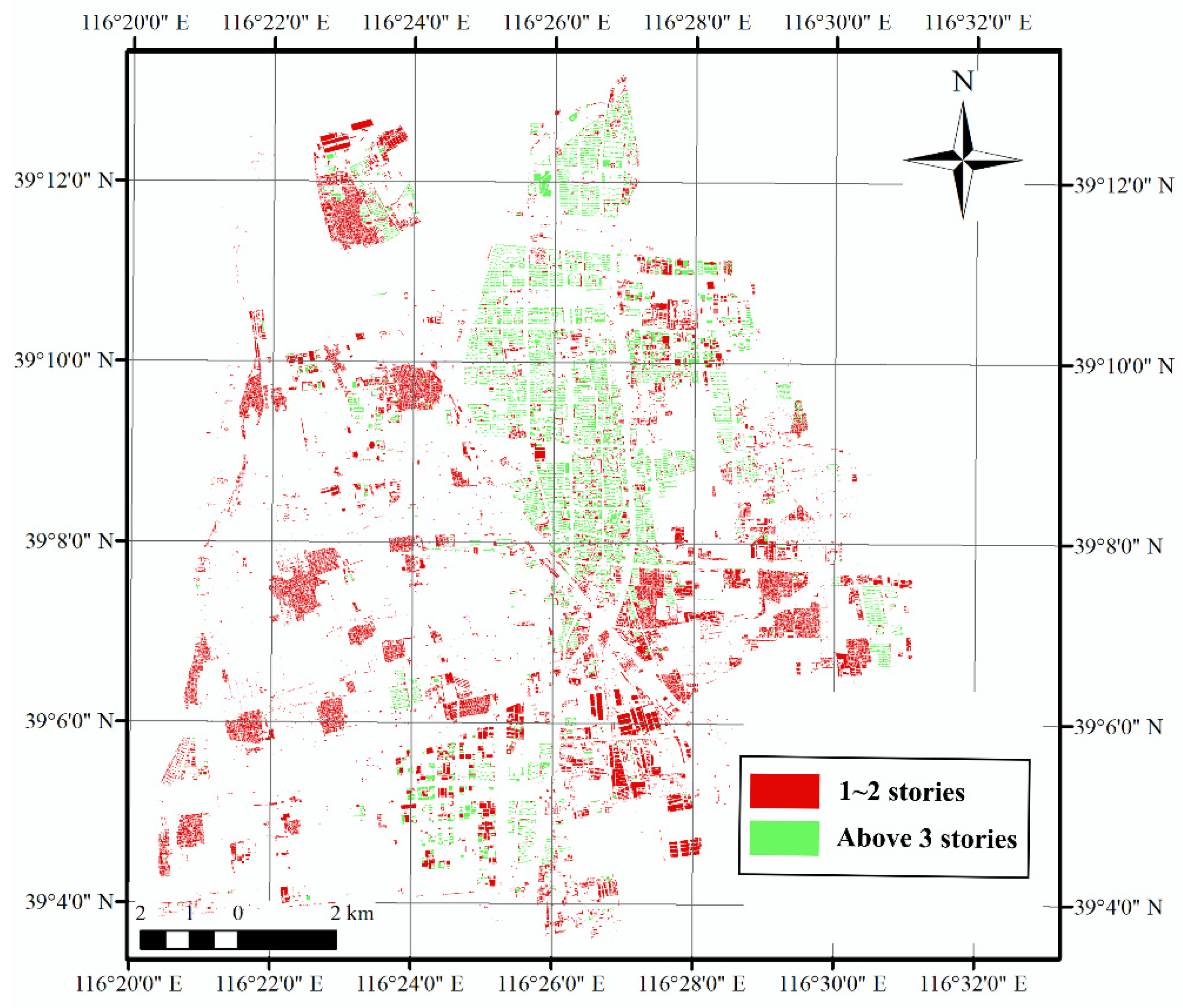

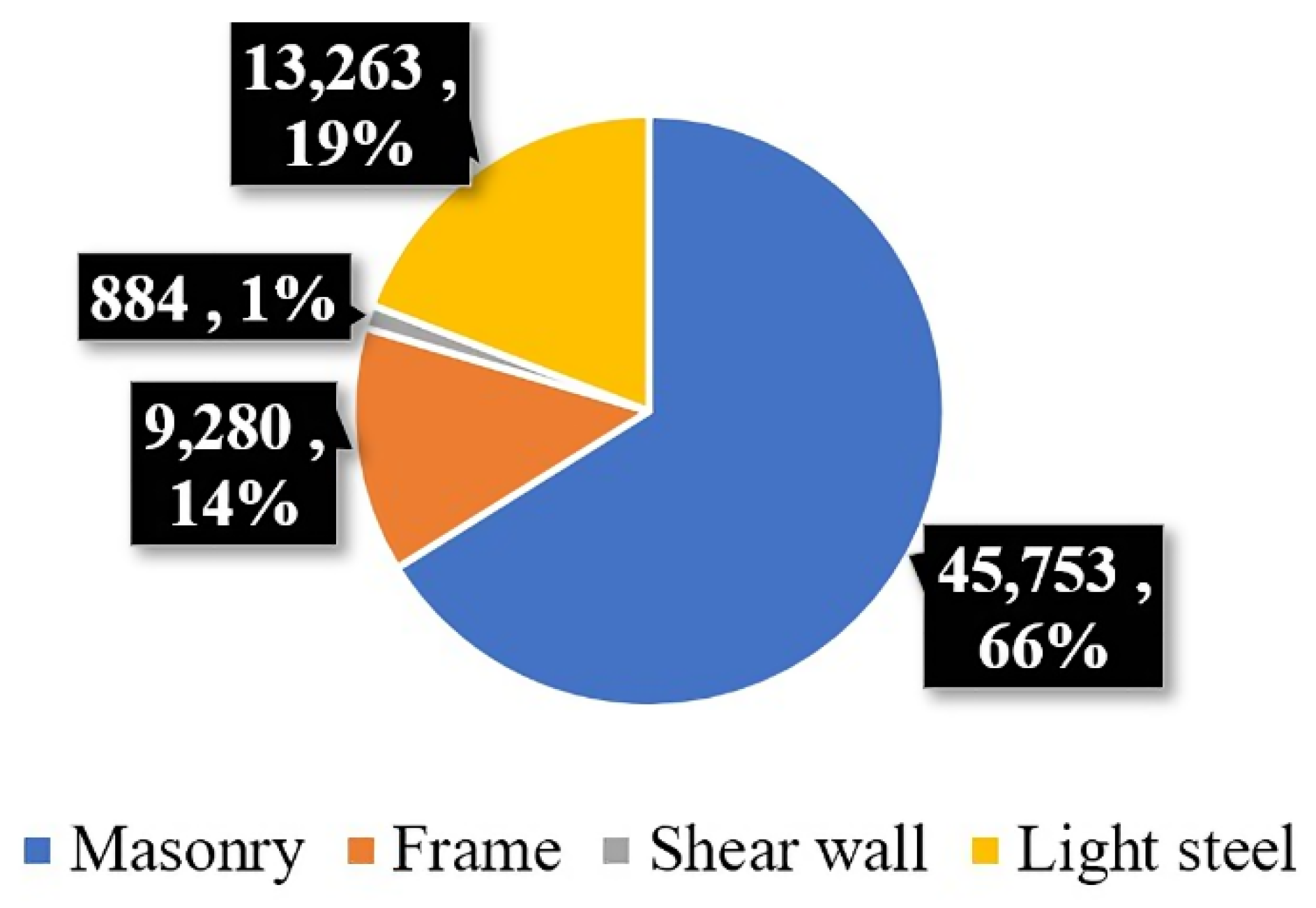
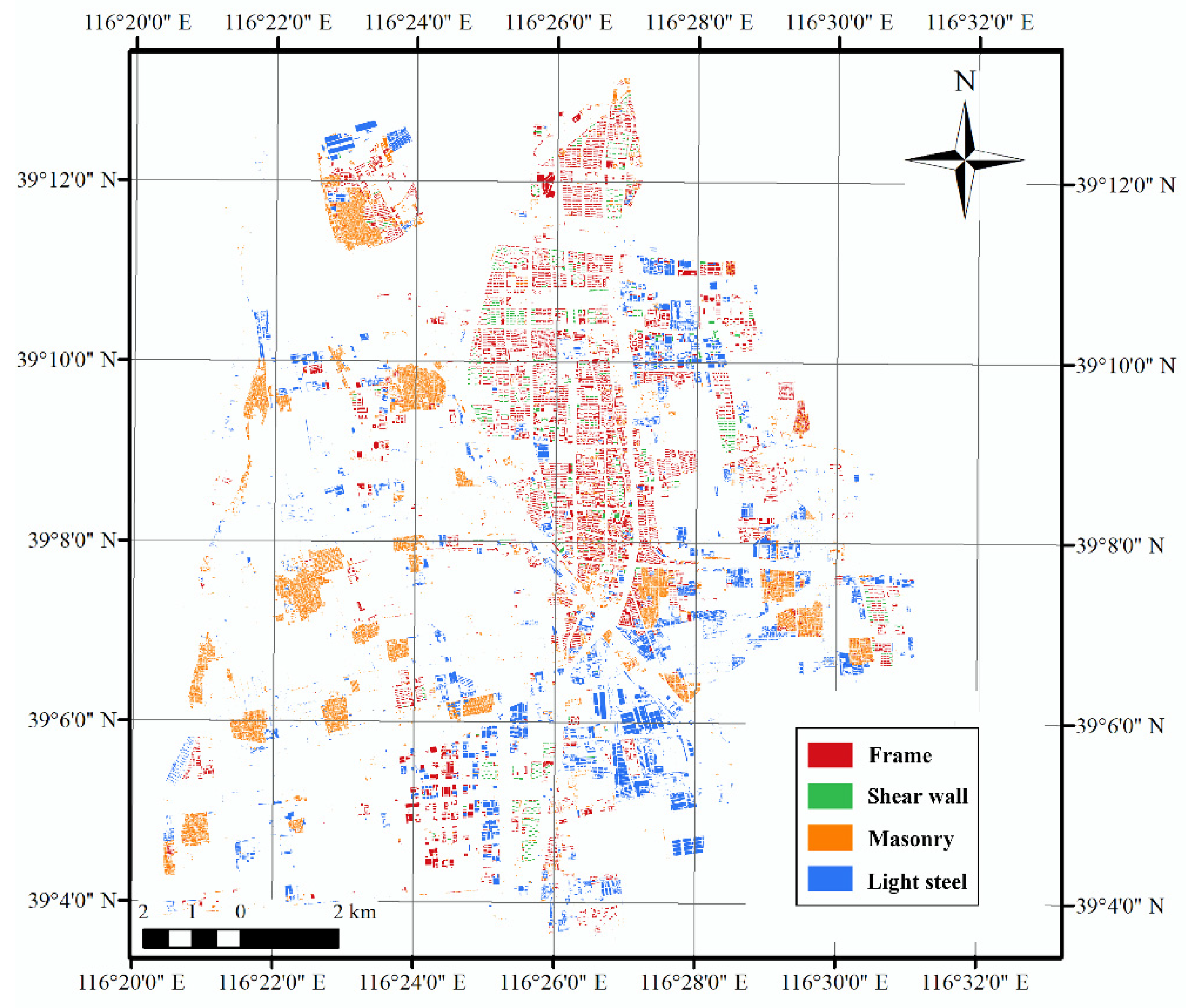
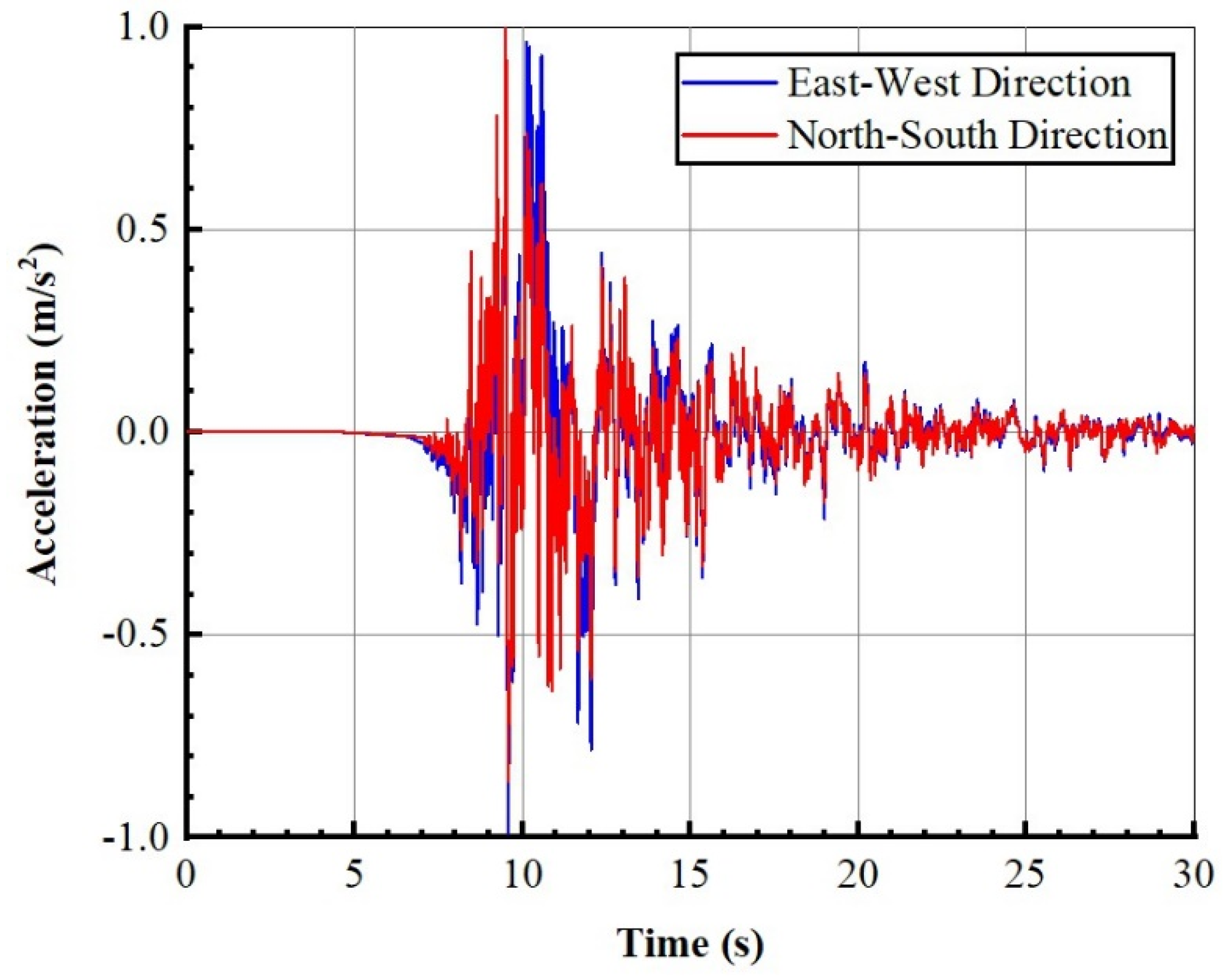
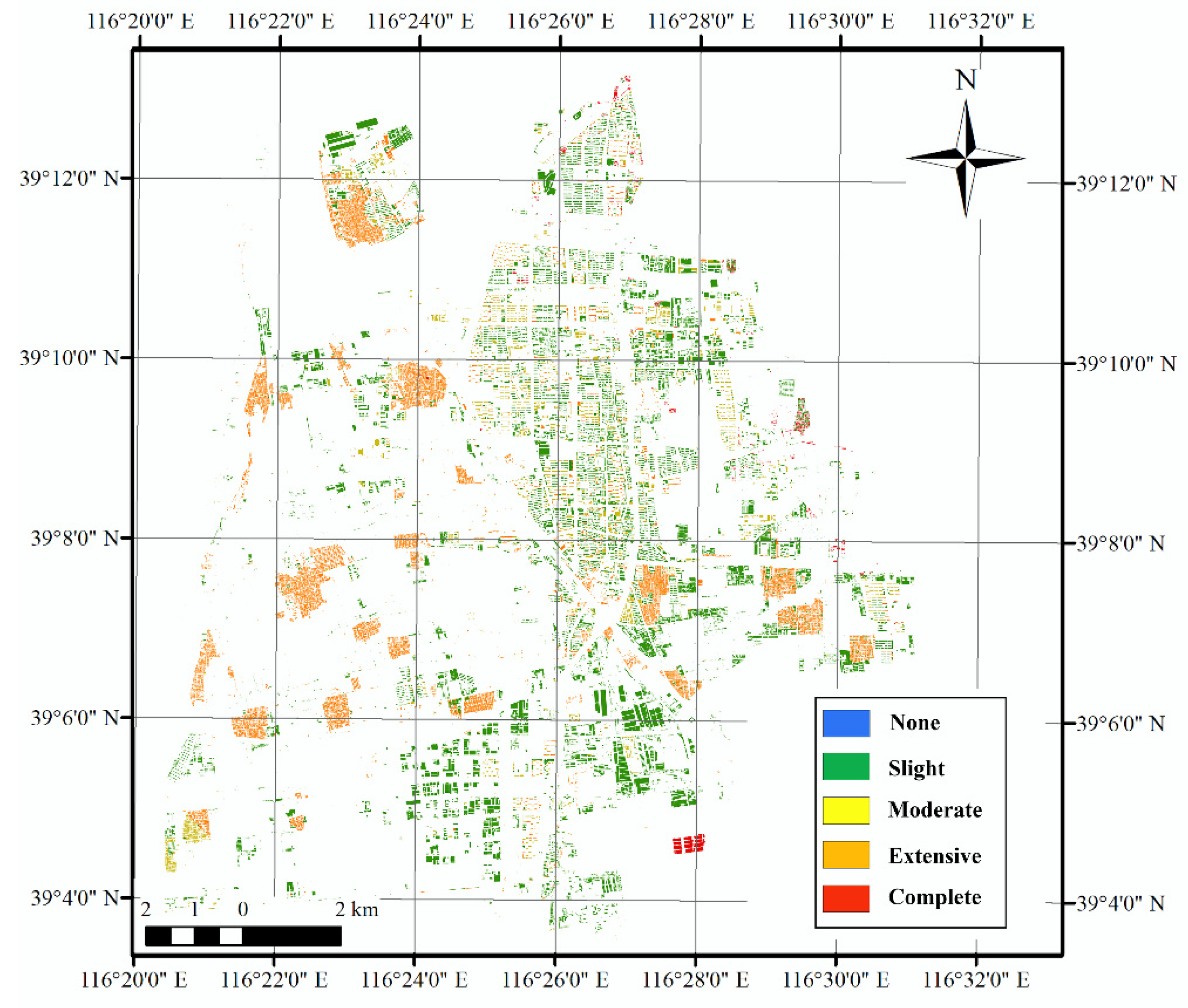

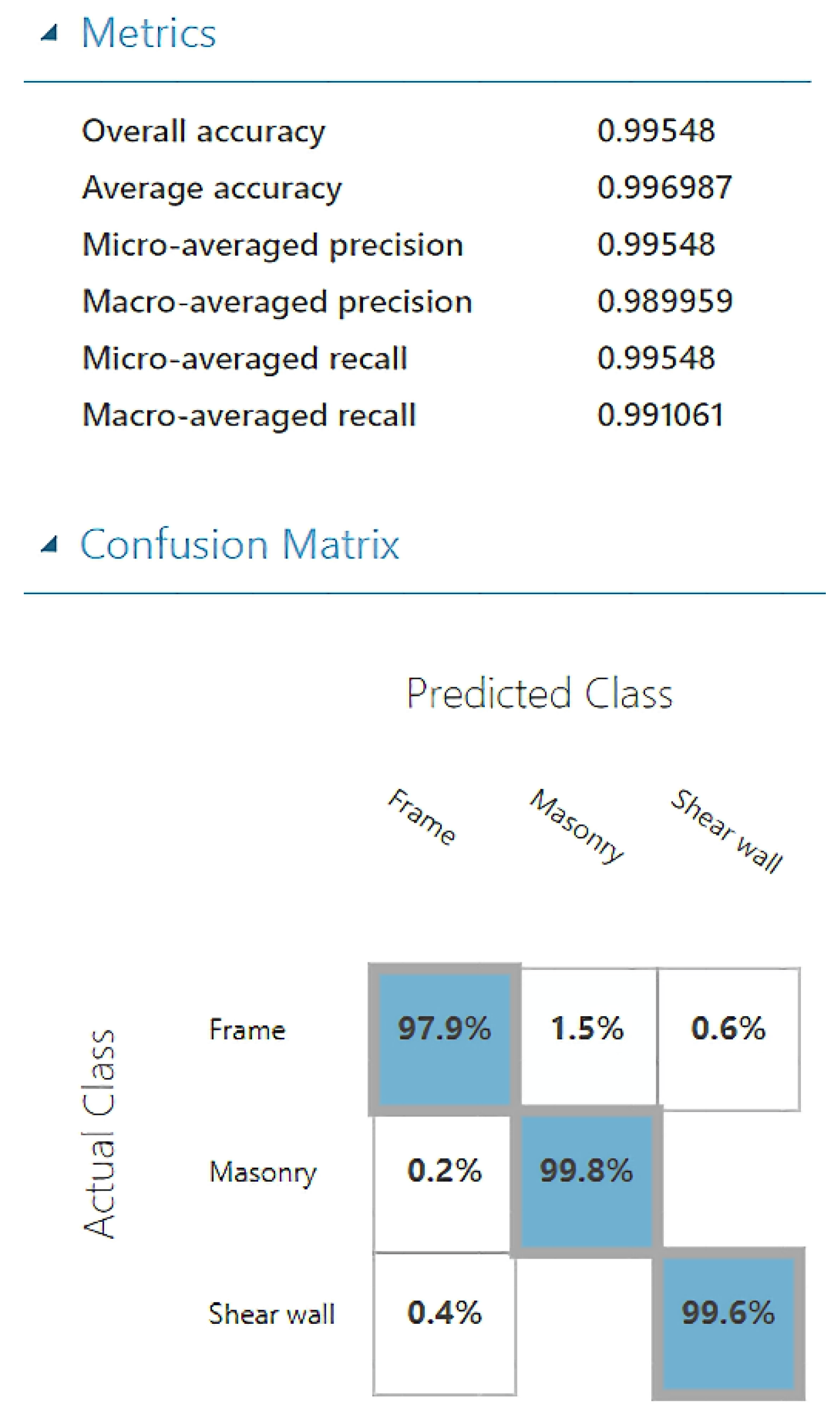
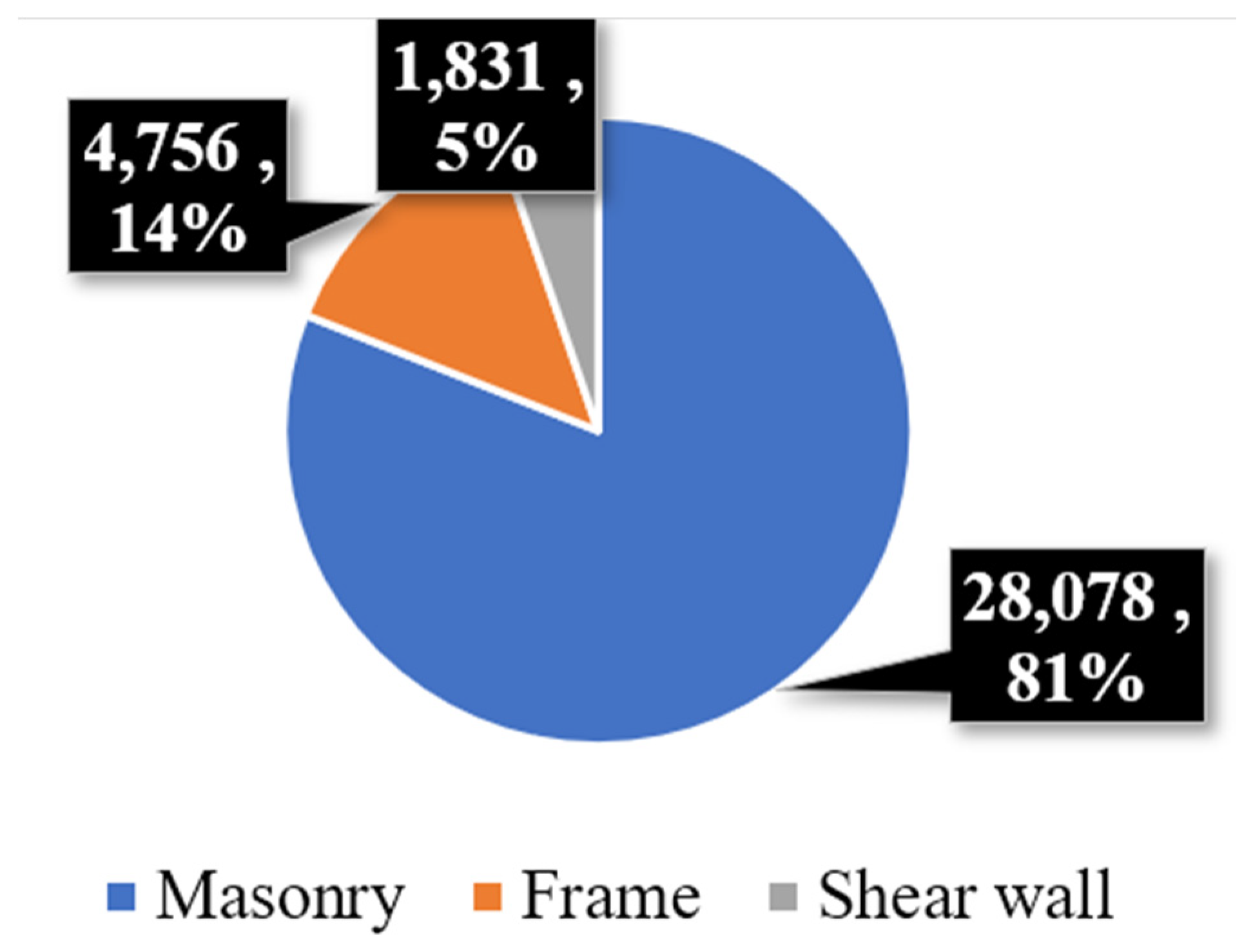
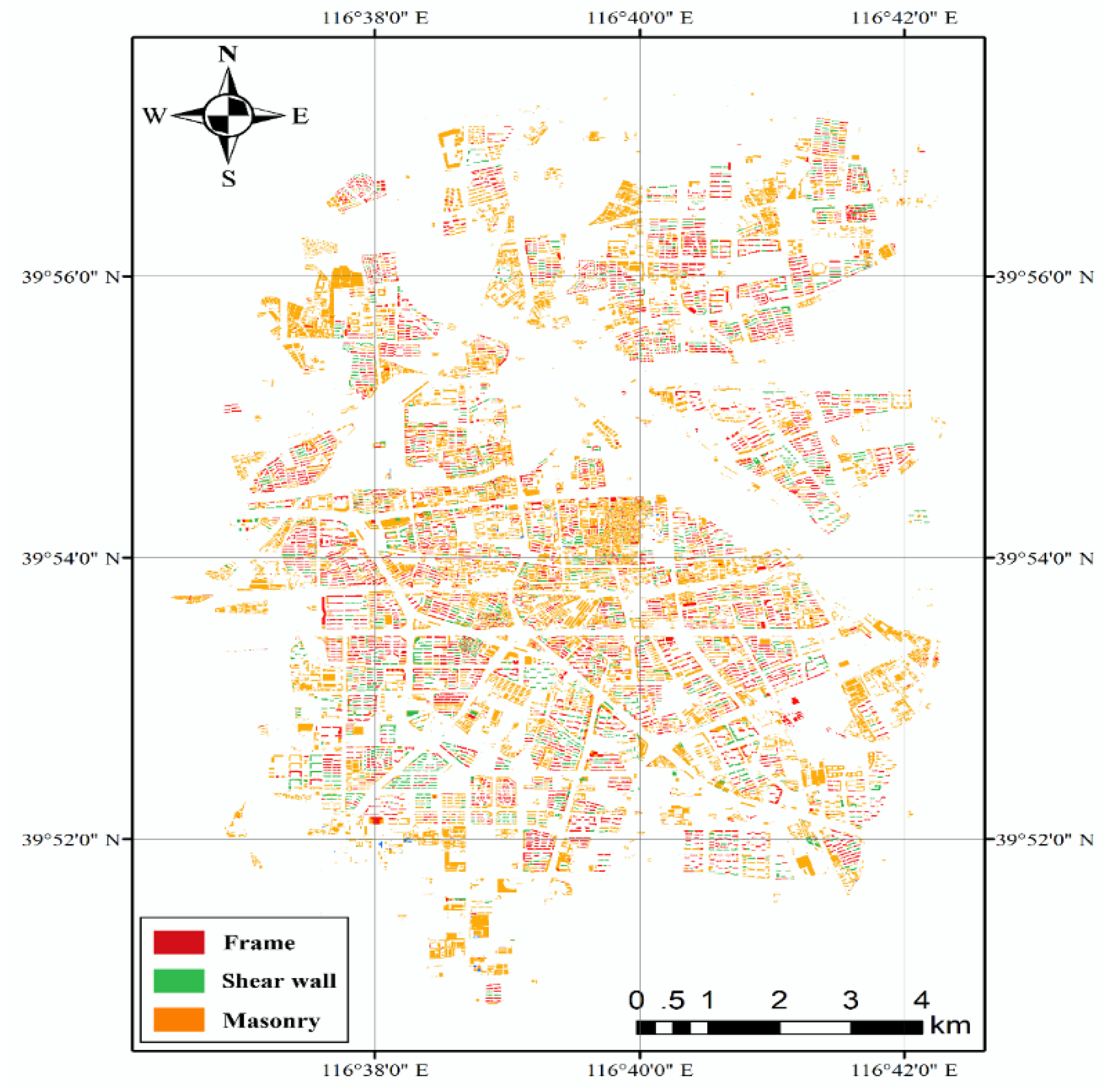
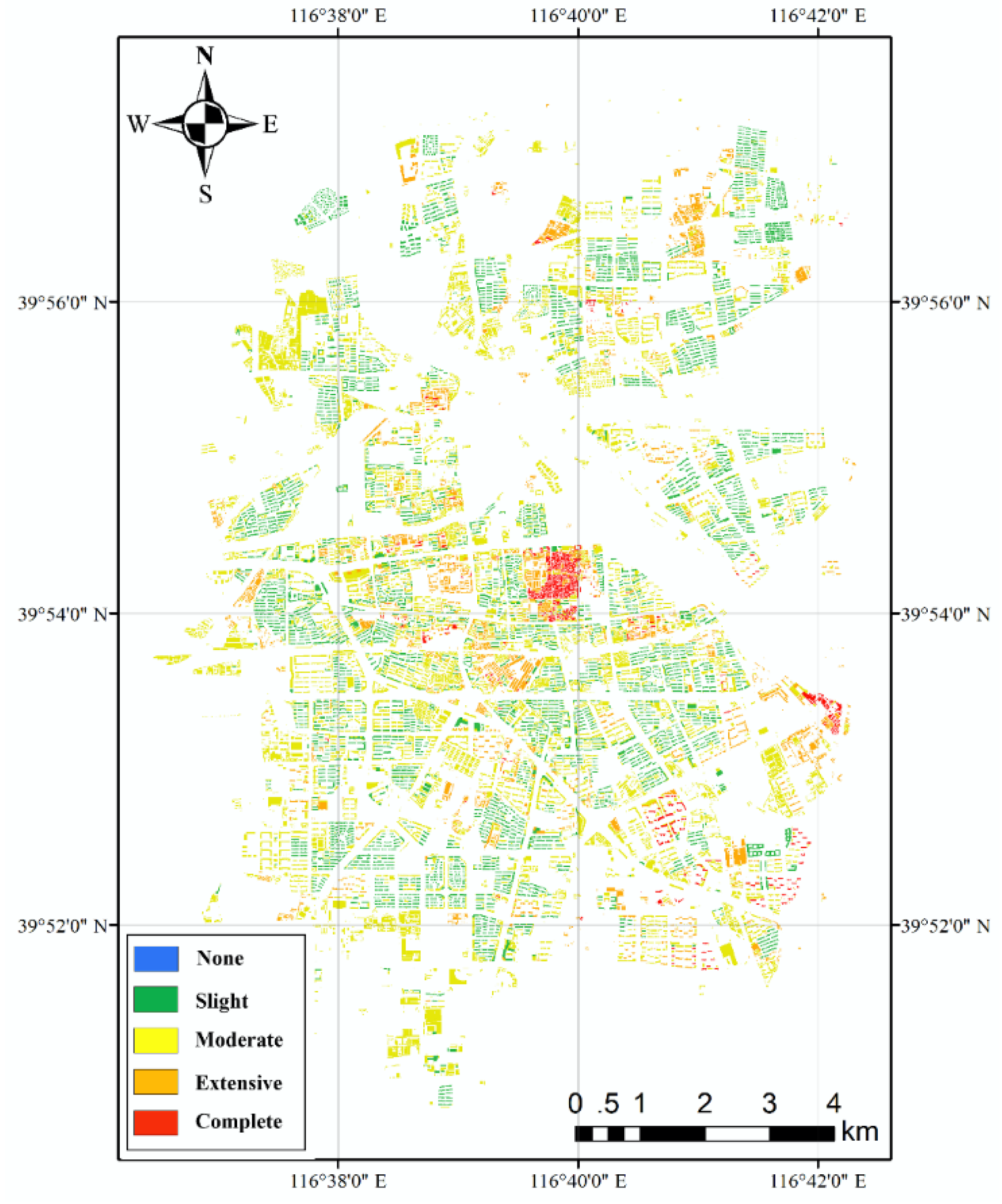
| ML Model | Macro F1 Score | Micro F1 Score |
|---|---|---|
| Decision forest | 96.9% | 98.3% |
| Artificial neural network | 96.3% | 98.0% |
| Logistic regression | 94.6% | 97.0% |
| Structure Type | Real Data | Prediction Results | Error |
|---|---|---|---|
| Masonry | 87.07% | 83.68% | 3.40% |
| Frame | 10.78% | 14.18% | −3.40% |
| Shear wall | 2.14% | 2.14% | 0.00% |
| Masonry | Frame | Shear Wall | Light Steel | Total |
|---|---|---|---|---|
| 385 | 238 | 761 | 691 | 2075 |
© 2020 by the authors. Licensee MDPI, Basel, Switzerland. This article is an open access article distributed under the terms and conditions of the Creative Commons Attribution (CC BY) license (http://creativecommons.org/licenses/by/4.0/).
Share and Cite
Xu, Z.; Wu, Y.; Qi, M.-z.; Zheng, M.; Xiong, C.; Lu, X. Prediction of Structural Type for City-Scale Seismic Damage Simulation Based on Machine Learning. Appl. Sci. 2020, 10, 1795. https://doi.org/10.3390/app10051795
Xu Z, Wu Y, Qi M-z, Zheng M, Xiong C, Lu X. Prediction of Structural Type for City-Scale Seismic Damage Simulation Based on Machine Learning. Applied Sciences. 2020; 10(5):1795. https://doi.org/10.3390/app10051795
Chicago/Turabian StyleXu, Zhen, Yuan Wu, Ming-zhu Qi, Ming Zheng, Chen Xiong, and Xinzheng Lu. 2020. "Prediction of Structural Type for City-Scale Seismic Damage Simulation Based on Machine Learning" Applied Sciences 10, no. 5: 1795. https://doi.org/10.3390/app10051795
APA StyleXu, Z., Wu, Y., Qi, M.-z., Zheng, M., Xiong, C., & Lu, X. (2020). Prediction of Structural Type for City-Scale Seismic Damage Simulation Based on Machine Learning. Applied Sciences, 10(5), 1795. https://doi.org/10.3390/app10051795





